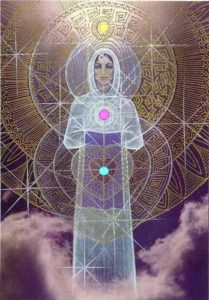
One image can say so much. In this stunning art piece I see a luminous vision of the Divine Feminine that speaks volumes. To me, the way in which the feminine figure and golden symmetries blend seems to link her with sacred knowledge and patterns of creation — just as Sophia, or Holy Wisdom, is often described in sacred texts. The luminosity of the feminine being represented here strongly suggests the subtle realms which visionaries have visited in altered states of consciousness and returned to describe for humanity.
Is Sophia an archetype, a personification, or a living being? In author and teacher Robert Powell’s audio course, “The Sophia Teachings,” he states that she is a living being. He says: “For the ancient Greeks, who first used the word ‘philosophy,’ Divine Wisdom was not something abstract; it was a real spiritual being whose name was Sophia.” He also mentions that the word philo-Sophia was originally understood as “love of Sophia,” i.e. love of Divine Wisdom. This divine feminine figure has been known by other names:
Hohkma (Hebrew)
Sapienta (Latin)
Mother of All (Gnostic)
Holy Spirit (Early Christian)
Powell isn’t the first person to say that Sophia is a living being. A number of visionaries have mentioned Sophia’s influence in their work and writings.
In the Wisdom Books of the Old Testament, we hear King Solomon speak about Sophia, whom he loves:
“I loved Sophia and sought her out from my youth, and I sought to take her for my bride, and I became enamored of her beauty….When I come into my house, I find rest with her. For converse has no bitterness, and to live with her has no pain, but gladness and joy…And in assiduous communing with her is understanding.” (Wisdom 8:2, 16, 18)
Granted, we can’t consult King Solomon about whether he’s talking about an archetype, personification, or a living being. However, we know from the writings of more contemporary commentators that they, at least, don’t see Sophia as an abstraction. Philosophers, mystics, theologians, writers, artists, poets, and at least one scientist, Teilhard de Chardin, have said they have sought and been inspired by Sophia.

I first mention Nicholas Roerich, Russian visionary and artist (1874-1947), because of my love for one of his paintings, The Mother of the World. It is a picture of a radiant woman veiled and seated on a throne, centered in a supernal royal blue background. Roerich observed that “Throughout the entire East and in the entire West there lives the Image of the Mother of the World, and deeply significant salutations are dedicated to this High Entity.” He writes further of her, “The Great Features of the Face are often covered and under the folds of this veil, glowing with the squares of perfection, may one not see the One Great Unifying Aspect, common to them All!”
I think Sophia and the Mother of the World blend together in Roerich’s painting, in the way Hildegard of Bingen describes in her visionary poem to Sophia.
Sophia
You of the whirling wings,
circling, encompassing energy of God:
you quicken the world in your clasp.
One wing soars in heaven,
one wing sweeps the earth,
and the third flies all around us.
Praise to Sophia!
Let all the earth praise her!
Here Sophia is portrayed as like a mother, an active and caring presence in the world: “One wing soars in heaven/one wing sweeps the earth….” I think of the fierceness of a mother bird protecting her chicks.
The Mother of the World, Nicholas Roerich
In Russia and the Ukraine Sophia has long been revered within eastern Christianity. One of Russia’s greatest philosophers, Vladimir Soloviev (1835-1900), had three mystical experiences of Sophia , in which he had a prophetic vision of her upcoming descent to Earth. He expresses this vision in one of his poems.
Today there is in the West a growing interest in Sophia. This corresponds with Soloviev’s prophetic vision of the upcoming descent of Sophia, which his poem records.
Let it be known: today the Eternal Feminine
In an incorruptible body is descending to Earth.
In the unfading light of the new Goddess
Heaven has become one with the depths.
Another notable visionary from the East wrote about The Universal Mother whose active participation in the world resembles Sophia’s. He is the Indian philosopher and mystic Sri Aurobindo (1872-1950). He writes:
“The Universal Mother works out whatever is transmitted by her transcendent consciousness from the Supreme and enters into the worlds that she has made; her presence fills and supports them with the divine spirit and the divine all-sustaining force and delight without which they could not exist. That which we call Nature or Prakriti is only her most outward executive aspect.”
In the West, priest, scientist, and visionary Teilhard de Chardin (1874-1947) wrote the Hymn to Matter in which Sophia speaks:
When the world was born, I came into being,
Before the centuries were made,
I issued from the hand of God…
I am the beauty running through the world,
To make it associate in ordered groups;
The ideal held up before the world
To make it ascend.
I am the essential Feminine.
In Istanbul one of the most famous churches in the world is named after Sophia, Hagia Sophia.
